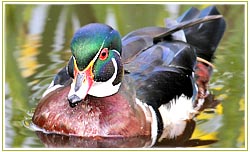About The Wood Duck
 The wood duck, Aix sponsa, is considered by many as one of the most beautiful species of waterfowl in North America – if not the world. Medium in size (approx. 19-21 inches), the wood duck have faces with white patches, long tails and a fine crest on their heads.
The wood duck, Aix sponsa, is considered by many as one of the most beautiful species of waterfowl in North America – if not the world. Medium in size (approx. 19-21 inches), the wood duck have faces with white patches, long tails and a fine crest on their heads.
A distinctively North American duck specie, wood ducks inhabit areas from southern Canada to the eastern, southern and western coasts of the United States – in swamps, creeks, river valleys, streams, lakes and forest bottomlands.
Although the male wood ducks are considered the more attractive gender with colorful bright patterns and striking breeding plumage, the female wood duck is smaller and less colorful, but also decidedly beautiful, distinguishable by her lightly tinted throat and her tear-drop shaped white ring around the eye.
The Wood Duck Nesting Preferences
The colorful wood duck is one of the only North American ducks that nest in trees (like oaks, willows and sycamores) . Their nests are usually found 1-15 meters above ground in hollow trunks or large branches often quite close to the water so that the female can lead her young there when the time comes.
The female only adds a layer of her own feathers before solely incubating the eggs. This incubation period lasts from 27-37 days.
Wood ducks will rarely be found nesting in buildings, but will willingly use nest boxes. These should be concealed in their preferred natural habitats rather than within sight of another nest box.
Building a Birdhouse For The Wood Duck
 Cavity-nesters such as Wood Ducks need their man-made birdhouse or nest-box to be carefully constructed according to the correct dimensions and in the right location, which in this case should be around wooded areas close to a body of water such as a river, lake, marsh etc. The floor should be 10 x 10 inches wide, with a frontal depth of cavity at 21 inches. The height of the entry holes should run 16 inches with a diameter of 4 inches. If the box is close to the water’s edge it should be around 5 feet above it, or if over land, allow a height of around 15 feet.
Cavity-nesters such as Wood Ducks need their man-made birdhouse or nest-box to be carefully constructed according to the correct dimensions and in the right location, which in this case should be around wooded areas close to a body of water such as a river, lake, marsh etc. The floor should be 10 x 10 inches wide, with a frontal depth of cavity at 21 inches. The height of the entry holes should run 16 inches with a diameter of 4 inches. If the box is close to the water’s edge it should be around 5 feet above it, or if over land, allow a height of around 15 feet.
The Wood Duck Mating Habits
The mating season of the wood duck begin to take place in the autumn and winter. This is the time the male wood duck’s beauty is in its full glory. Female wood ducks continuously flick their bills back over their shoulder, and when a male responds by raising his plumage (wings and tail) then swimming away with his head not facing her, this is a signal for her to follow him.
When the wood ducks find their partners, they migrate North to their breeding grounds together, to arrive there by spring. When one of the pair is lost along the way, the single wood duck finds another partner at the breeding grounds.
The Wood Duck Feeding Preferences
Wood ducks are mainly vegetarian, feeding on aquatic plants, seeds and fruits although ducklings may feed on small insects or fish, the protein being necessary for their growth.
Interesting Wood Duck Facts
 Again, the wood duck is known for its striking beauty and is no doubt one the most beautiful ducks in the world. It is considered to be a perching duck, with shaped clawed feet also webbed for swimming. At the turn of the century, the wood duck was near extinction. Today however, because of rigorous new laws, the wood ducks population is deemed safe.
Again, the wood duck is known for its striking beauty and is no doubt one the most beautiful ducks in the world. It is considered to be a perching duck, with shaped clawed feet also webbed for swimming. At the turn of the century, the wood duck was near extinction. Today however, because of rigorous new laws, the wood ducks population is deemed safe.